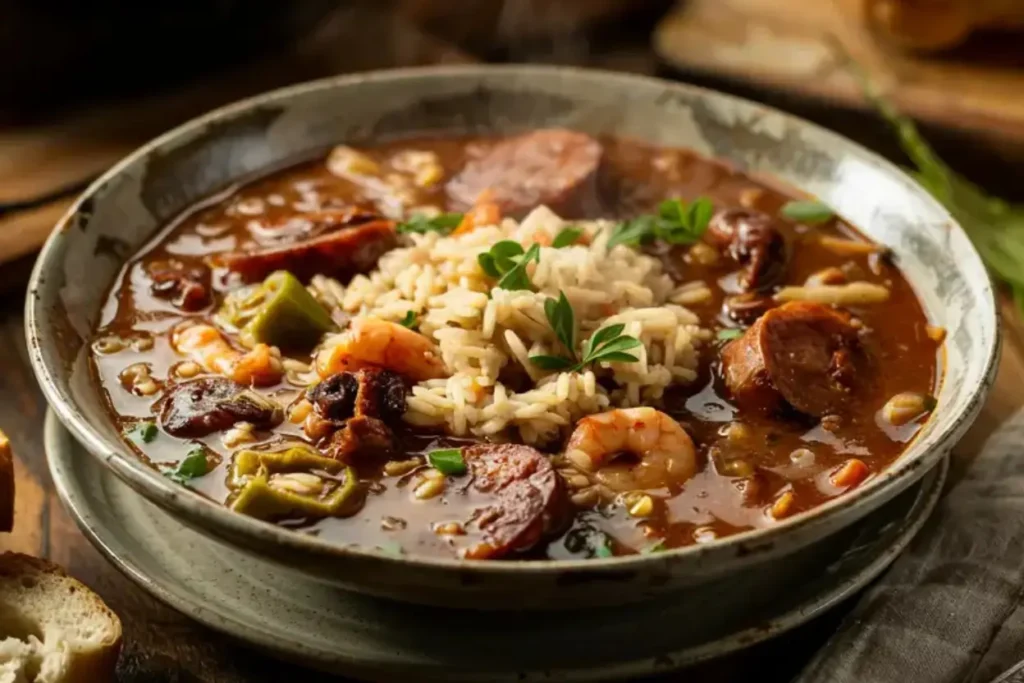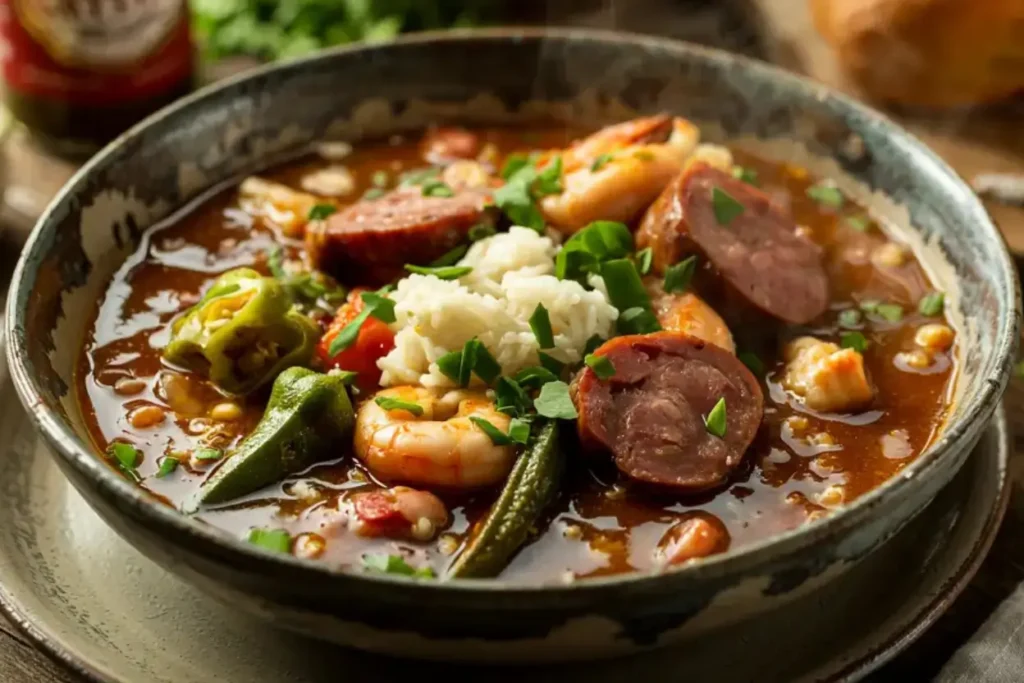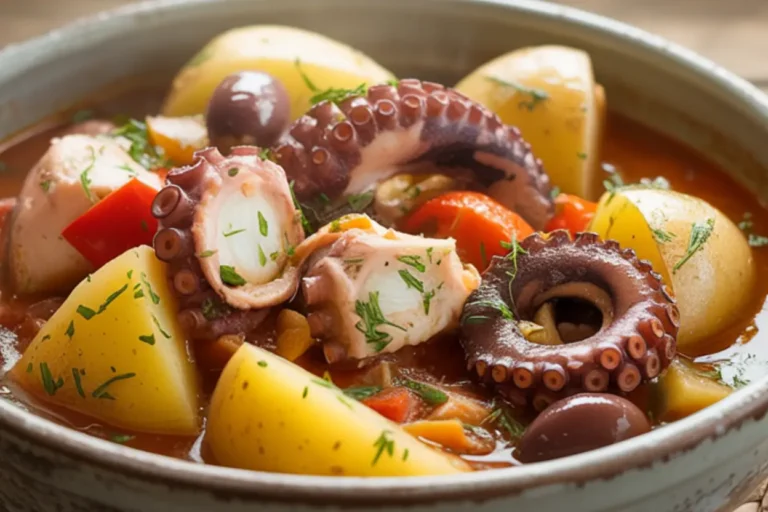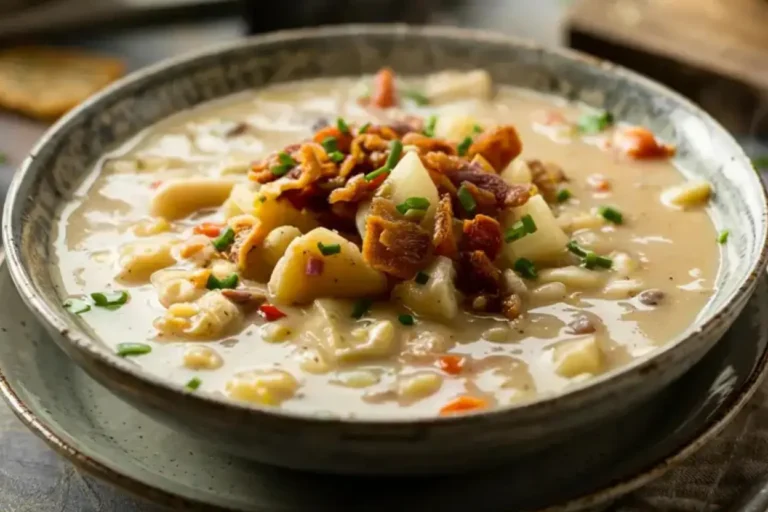New Orleans Style Gumbo Recipe: 10 Steps to Creole Perfection
Table of Contents
What is New Orleans Style Gumbo?
Ever wondered what makes a gumbo truly New Orleans style? Well, buckle up, food friends! New Orleans Style Gumbo is the delicious result of what happens when several cultures throw their favorite cooking techniques into one magnificent pot. It starts with a deep, dark roux (the darker, the better – we’re talking chocolate-brown here, folks!), then adds the “holy trinity” of Creole cooking: bell peppers, onions, and celery. Toss in some seafood, sausage, or chicken (or heck, why not all three?), and you’ve got yourself a dish that embodies the spirit of The Big Easy!
Thank you for reading this post, don't forget to subscribe!The locals joke that no two gumbos are ever the same, kind of like snowflakes, but much more delicious. As they say, “the way to a man’s heart is through his stomach,” and I haven’t met anyone yet who can resist a steaming bowl of authentic New Orleans-style gumbo. So grab your biggest pot and let’s laissez les bon temps rouler (let the good times roll) with this crowd-pleasing Louisiana classic!
How to Make New Orleans Style Gumbo:
Quick Overview
This New Orleans Style Gumbo is a labor of love that delivers exceptional flavor and impressive results. The foundation of any great gumbo is a properly made dark roux, which requires patience and attention but is surprisingly simple to master. Once your roux reaches that perfect chocolate color, the rest comes together relatively easily. While this isn’t a quick weeknight meal (plan for about 2.5-3 hours total, with about 1 hour of active cooking time), most of that is simmering time where the pot does the work while filling your home with mouthwatering aromas. The deep, rich flavors develop as it cooks, making this the perfect weekend project with leftovers that taste even better the next day.
The Ingredients I Use to Bring My New Orleans Style Gumbo to Life:
For the Roux:
- 1 cup vegetable oil
- 1 cup all-purpose flour
For the Gumbo:
- 1 large onion, finely diced
- 2 green bell peppers, finely diced
- 3 celery stalks, finely diced
- 6 cloves garlic, minced
- 1 pound andouille sausage, sliced into rounds
- 1 pound boneless, skinless chicken thighs, cut into bite-sized pieces
- 1 pound medium shrimp, peeled and deveined
- 8 cups chicken stock
- 2 tablespoons Creole seasoning
- 2 bay leaves
- 1 tablespoon dried thyme
- 1 teaspoon cayenne pepper (adjust to taste)
- 2 tablespoons Worcestershire sauce
- 1 tablespoon file powder (ground sassafras)
- 1 cup okra, sliced (fresh or frozen)
- 1/4 cup fresh parsley, chopped
- 1/4 cup green onions, thinly sliced
For Serving:
- Cooked white rice
- Hot sauce (Crystal or Tabasco)
- French bread
Step-by-Step Instructions:
- Prepare your ingredients: Before starting your gumbo, it’s crucial to have everything chopped, measured, and ready to go. The roux-making process requires your full attention, so you won’t have time to chop vegetables once you start. Dice your trinity (onions, bell peppers, celery), mince your garlic, slice the sausage, and cut the chicken into bite-sized pieces. Place everything in separate bowls so they’re ready to add at the right moment.
- Make the roux: In a large, heavy-bottomed Dutch oven, heat the vegetable oil over medium heat. Once hot, add the flour gradually while whisking constantly. Continue whisking without stopping – this is crucial to prevent burning. The roux will progress from white to blonde to peanut butter color, and finally to a dark chocolate brown, which takes approximately 25-30 minutes. Be patient and maintain a medium heat; if it starts smoking or you see black specks, it’s burned and you’ll need to start over.
- Add the trinity: As soon as your roux reaches that deep chocolate color, immediately add the diced onions, bell peppers, and celery. The vegetables will sizzle and stop the roux from cooking further. Stir constantly for about 5 minutes until the vegetables start to soften. Stir in the minced garlic and cook for about a minute, just until it becomes fragrant
- Brown the proteins: Add the sliced andouille sausage to the pot and cook for about 5 minutes until it begins to brown. Then add the chicken pieces and cook for another 5 minutes, stirring occasionally to ensure even browning and to prevent sticking.
- Add the liquid and seasonings: Slowly pour in the chicken stock, stirring continuously to incorporate the roux smoothly without lumps. Add the Creole seasoning, bay leaves, thyme, cayenne pepper, and Worcestershire sauce. Bring the mixture to a boil, then reduce heat to low and simmer, uncovered, for 1 hour to allow flavors to meld and the chicken to become tender.
- Incorporate okra: After the gumbo has simmered for an hour, add the sliced okra and continue to simmer for another 30 minutes. The okra helps thicken the gumbo naturally while adding authentic flavor.
- Add the shrimp: In the last 10 minutes of cooking, add the peeled and deveined shrimp. They cook quickly and will become tough if overcooked, so add them just before serving.
- Finish with filé powder: Turn off the heat and stir in the filé powder. It’s important to add this off the heat as prolonged cooking can make it stringy or bitter. The filé powder adds earthy flavor and helps thicken the gumbo.
- Rest and skim: Allow the gumbo to rest for 10-15 minutes. During this time, skim off any excess oil that has risen to the surface with a large spoon.
- Garnish and serve: Just before serving, stir in the fresh parsley and green onions. Serve the gumbo in deep bowls over a scoop of white rice. Provide hot sauce on the table for those who want extra heat.
What to Serve New Orleans Style Gumbo With:
New Orleans Style Gumbo is practically a one-pot meal, but a few accompaniments will complete your Creole feast perfectly. White rice is non-negotiable – it’s the traditional base for soaking up all that flavorful gravy. Warm, crusty French bread or cornbread also makes an excellent pairing, perfect for dunking and ensuring you don’t miss a drop of that delicious broth.
For drinks, consider a cold Abita beer (a Louisiana favorite) or sweet tea for an authentic Southern meal. If you’re hosting a special dinner, start with a simple green salad dressed with vinaigrette to balance the rich flavors. For dessert, continue the New Orleans theme with bread pudding or beignets dusted with powdered sugar.
For a full New Orleans experience, add a side of simple collard greens or a small serving of red beans – both traditional Louisiana accompaniments that complement the gumbo beautifully without overwhelming your meal.

Top Tips for Perfecting New Orleans Style Gumbo:
- Take your time with the roux: The darker the roux, the more flavorful your gumbo will be. Don’t rush this step or crank up the heat trying to speed it along. A proper dark chocolate-colored roux takes about 25-30 minutes of constant stirring. Use a wooden spoon or flat whisk for best results.
- Use the right pot: A heavy-bottomed cast-iron Dutch oven is ideal for gumbo. It distributes heat evenly, preventing hot spots that could burn your roux, and retains heat perfectly for the long simmering process.
- Don’t crowd the seafood: If using multiple types of seafood, add them in stages according to cooking time. Shrimp need just a few minutes, while crab claws or oysters might need a bit longer. Overcooked seafood becomes tough and rubbery.
- Season carefully: Remember that many ingredients (especially the andouille sausage and Creole seasoning) contain salt. Taste before adding additional salt, and adjust final seasoning only at the end of cooking when flavors have developed.
- Understand thickening agents: Traditional gumbo uses three thickening methods: roux, okra, and filé powder. You can emphasize any of these based on preference – more okra for vegetable flavor, darker roux for nuttiness, or more filé for an earthy finish.
- Give it time: Like many stews, gumbo tastes even better the next day when flavors have had time to meld. Consider making it a day ahead for special occasions.
Storing and Reheating Tips:
New Orleans Style Gumbo is one of those rare dishes that actually improves with time as the flavors continue to develop. To store leftover gumbo, allow it to cool completely before transferring to airtight containers. Refrigerated gumbo will keep well for 3-4 days. For best results, store the gumbo separately from the rice, as rice tends to absorb liquid and become mushy when stored in the gumbo.
If you want to prepare ahead for future meals, gumbo freezes beautifully for up to 3 months. I recommend freezing it without the rice and seafood if possible. Freeze in portion-sized containers, leaving about an inch of space at the top for expansion. Thaw overnight in the refrigerator before reheating.
When reheating gumbo, do so gently over medium-low heat, stirring occasionally until warmed through. Avoid vigorous boiling, which can break down the texture of the vegetables and proteins. If the gumbo seems too thick after refrigeration, add a small amount of chicken broth to reach your desired consistency. If you’re reheating a batch without seafood, you can add freshly cooked shrimp to the reheated gumbo just before serving for the best texture.
For the fullest flavor when serving previously stored gumbo, add a sprinkle of fresh parsley and green onions just before serving to brighten the dish and give it that just-made appeal.
click here to follow me on pinterest
New Orleans Style Gumbo Recipe: 10 Steps to Creole Perfection
Cuisine: Cajun Creole / Southern USDifficulty: Intermediate8
servings30
minutes2
hours20
minutes450-550
kcalThis hearty and flavorful New Orleans Style Gumbo brings the soul of Louisiana cuisine to your table. It features a rich, dark roux, the classic trinity of onion, bell pepper, and celery, and a savory mix of chicken, andouille sausage, and shrimp. Bold with Creole spices and thickened with okra and file powder, this dish is the epitome of comfort food served over warm white rice.
Ingredients
1 cup vegetable oil
1 cup all-purpose flour
1 large onion, finely diced
2 green bell peppers, finely diced
3 celery stalks, finely diced
6 cloves garlic, minced
1 pound andouille sausage, sliced into rounds
1 pound boneless, skinless chicken thighs, cut into bite-sized pieces
1 pound medium shrimp, peeled and deveined
8 cups chicken stock
2 tablespoons Creole seasoning
2 bay leaves
1 tablespoon dried thyme
1 teaspoon cayenne pepper (adjust to taste)
2 tablespoons Worcestershire sauce
1 tablespoon file powder (ground sassafras)
1 cup okra, sliced (fresh or frozen)
1/4 cup fresh parsley, chopped
1/4 cup green onions, thinly sliced
Cooked white rice
Hot sauce (Crystal or Tabasco)
French bread
Instructions
- Prep Everything First
Chop the trinity (onion, bell pepper, celery), mince garlic, slice sausage, and cut chicken into bite-sized pieces. Have all ingredients measured and ready — once you start the roux, there’s no pausing. - Make the Roux
In a heavy Dutch oven, heat 1 cup of oil over medium. Whisk in 1 cup flour gradually and whisk constantly for 25–30 minutes until the roux turns a dark chocolate brown. Do not stop whisking or it may burn. - Add the Trinity
Immediately stir in the diced onions, bell peppers, and celery. Cook for 5 minutes, stirring often. Add the minced garlic and cook for 1 more minute until fragrant. - Brown the Sausage and Chicken
Add sliced andouille sausage and cook for 5 minutes until browned. Then add chicken and cook another 5 minutes, stirring occasionally. - Pour in Stock and Seasonings
Slowly stir in 8 cups of chicken stock to blend the roux evenly. Add Creole seasoning, bay leaves, thyme, cayenne, and Worcestershire sauce. Bring to a boil, then reduce to a simmer. - Simmer to Build Flavor
Simmer uncovered on low heat for 1 hour. This allows the flavors to meld and the chicken to tenderize. - Add the Okra
Stir in the sliced okra and simmer for another 30 minutes. It adds flavor and helps thicken the gumbo naturally. - Add the Shrimp
In the final 10 minutes of cooking, add the shrimp. Cook just until pink and opaque — don’t overcook! - Stir in the File Powder and Rest
Turn off the heat. Stir in filé powder for added flavor and texture. Let the gumbo rest for 10–15 minutes, then skim off any excess oil from the top. - Garnish and Serve
Stir in fresh parsley and green onions. Serve hot over white rice with hot sauce and crusty French bread on the side.
Notes
- This gumbo starts with a deep, rich dark roux—the heart and soul of any good gumbo. It takes time and patience, but it’s essential for that authentic nutty flavor. The combination of chicken, sausage, and shrimp creates layers of flavor, while the file powder and okra give the gumbo its classic thickness and earthy depth. Don’t skip the rice or French bread — they help soak up every delicious bite. And if you’re a fan of heat, a splash of Crystal or Tabasco hot sauce on top makes it truly Louisiana-style.




